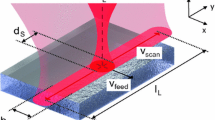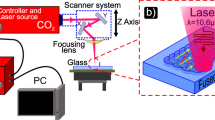Abstract
Microfluidic chip, with the advantage of compact structure and low reagent consumption, has rapidly emerged as the key technologies in bio(chemical) analysis and materials generation. In this work, a facile method is presented to fabricate reusable microfluidic in fused silica glass using femtosecond double-pulse laser-assisted polarization-selective wet etching. Three methods of dark treatment, chemical treatment and static treatment are used to effectively control the wettability of the surface of microchannel to increase the reuse rate of the microfluidic chip. Furthermore, simulations and experiments for three different kinds of Y-shaped micromixers are carried out to achieve better mixing function of microfluidic. Results indicate that arc-shaped channels have better mixing function than square-wave-shaped channel and linear-shaped channels. Finally, the application of oil-in-water and water-in-oil droplet preparation is carried out using the prepared microfluidic. It is find that the volume of each drop is about 1.5 × 10−3–2.5 × 10−2 μL. We believe the work in this paper will provide important theories and technologies for the rapid development of microfluidic chips and femtosecond laser processing.







Similar content being viewed by others
References
J. Castillo-Leon, W.E. Svendsen et al., Lab-on-a-chip devices and micro-total analysis systems (Springer, Dordrecht, 2015), pp. 1–241
D. Chu, P. Yao et al., Ablation enhancement of fused silica glass by femtosecond laser double-pulse Bessel beam. J. Opt. Soc. Am. B 11(37), 3535–3541 (2020)
Y. Ju, Y. Liao et al., Fabrication of large-volume microfluidic chamber embedded in glass using three-dimensional femtosecond laser micromachining. Microfluid. Nanofluid. 11(1), 111–117 (2011)
C. Shan, F. Chen et al., Multi-microchannel helical mixer fabricated by femtosecond laser inside fused silica. Micromach. Basel 9(1), 29 (2018)
Y. Liao, J. Song et al., Rapid prototyping of three-dimensional microfluidic mixers in glass by femtosecond laser direct writing. Lab Chip 12(4), 746–749 (2012)
L. Shang, Y. Cheng et al., Emerging droplet microfluidics. Chem. Rev. 117(12), 7964–8040 (2017)
R. Zilionis, J. Nainys et al., Single-cell barcoding and sequencing using droplet microfluidics. Nat. Protoc. 12(1), 44–73 (2017)
S. Mashaghi, A. Abbaspourrad et al., Droplet microfluidics: a tool for biology, chemistry and nanotechnology. TrAC-Trends Anal. Chem. 82, 118–125 (2016)
D.M. Headen, J.R. García et al., Parallel droplet microfluidics for high throughput cell encapsulation and synthetic microgel generation. Microsyst. Nanoeng. 4(1), 17076 (2018)
P. Liu, L. Jiang et al., Etching rate enhancement by shaped femtosecond pulse train electron dynamics control for microchannels fabrication in fused silica glass. Opt. Lett. 38(22), 4613–4616 (2013)
S. Darvishi, T. Cubaud et al., Ultrafast laser machining of tapered microchannels in glass and PDMS. Opt. Laser Eng. 50(2), 210–214 (2012)
C.W. Tsao, L. Hromada et al., Low temperature bonding of PMMA and COC microfluidic substrates using UV/ozone surface treatment. Lab Chip 7(4), 499–505 (2007)
X. Yan, L. Jiang et al., Polarization-independent etching of fused silica based on electrons dynamics control by shaped femtosecond pulse trains for microchannel fabrication. Opt. Lett. 39(17), 5240 (2014)
A.E. Vasdekis, M.J. Wilkins et al., Solvent immersion imprint lithography. Lab Chip 14(12), 2072–2080 (2014)
S. Agarwala, G.L. Goh et al., Development of bendable strain sensor with embedded microchannels using 3D printing. Sens. Actuators A- Phys. 263, 593–599 (2017)
N.G. Batz, J.S. Mellors et al., Chemical vapor deposition of aminopropyl silanes in microfluidic channels for highly efficient microchip capillary electrophoresis-electrospray ionization-mass spectrometry. Anal. Chem. 86(7), 3493–3500 (2014)
A. Daridon, V. Fascio et al., Multi-layer microfluidic glass chips for microanalytical applications. J. Anal. Chem. 371(2), 261–269 (2001)
J. Wu, R. Chantiwas et al., Complete plastic nanofluidic devices for DNA analysis via direct imprinting with polymer stamps. Lab Chip 11(17), 2984–2989 (2011)
H. Cheng, C. Han et al., Sensitivity enhancement by field-amplified sample injection in interfacing microchip electrophoresis with inductively coupled plasma mass spectrometry for bromine speciation in bread. Food Anal. Method 7(10), 2153–2162 (2014)
L. Griscom, P. Degenaar et al., Cell placement and neural guidance using a three-dimensional microfluidic array[J]. Jpn. J. Appl. Phys. 40(1), 5485–5490 (2001)
J.R. Wu, J. He et al., Robust hierarchical porous PTFE film fabricated via femtosecond laser for self-cleaning passive cooling. Nano Lett. 21(10), 4209–4216 (2021)
S. Yang, K. Yin et al., Ultrafast nano-structuring of superwetting Ti foam with robust antifouling and stability towards efficient oil-in-water emulsion separation. Nanoscale 11, 17607–17614 (2019)
D. Chu, X. Sun et al., Substrate-independent, switchable bubble wettability surfaces induced by ultrasonic treatment. Soft Matter 15(37), 7398–7403 (2019)
D. Chu, S.C. Singh et al., Superamphiphobic surfaces with controllable adhesion fabricated by femtosecond laser Bessel beam on PTFE. Adv. Mater. Interfaces 6(14), 1900550 (2019)
M. Masuda, K. Sugioka et al., 3-D microstructuring inside photosensitive glass by femtosecond laser excitation. Appl. Phys. A-Mater. 76(5), 857–860 (2003)
Y. Li, K. Itoh et al., Three-dimensional hole drilling of silica glass from the rear surface with femtosecond laser pulses. Opt. Lett. 26(23), 1912–1914 (2001)
Q. Sun, A. Saliminia et al., Microchannel fabrication in silica glass by femtosecond laser pulses with different central wavelengths. J. Micromech. Microeng. 18(3), 35039 (2008)
Z. Wang, L. Jiang et al., High-throughput microchannel fabrication in fused silica by temporally shaped femtosecond laser Bessel-beam-assisted chemical etching. Opt. Lett. 43(1), 98–101 (2018)
Y. Liao, Y. Ju et al., Three-dimensional microfluidic channel with arbitrary length and configuration fabricated inside glass by femtosecond laser direct writing. Opt. Lett. 35(19), 3225–3227 (2010)
D. Chu, X. Sun et al., Effect of double-pulse-laser polarization and time delay on laser-assisted etching of fused silica. J. Phys. D-Appl. Phys. 50(46), 465306 (2017)
R. Wang, N. Sakai et al., Studies of surface wettability conversion on TiO2 Single-Crystal Surfaces. J. Phys. Chem. B 103(12), 2188–2194 (1999)
D. Chu, P. Yao et al., Anti-reflection silicon with self-cleaning processed by femtosecond laser. Opt. Laser Technol. 136, 106790 (2021)
J. Long, M. Zhong et al., Superhydrophilicity to superhydrophobicity transition of picosecond laser microstructured aluminum in ambient air. J. Colloid Interface Sci. 441, 1–9 (2015)
X. Jia, Y. Chen et al., Advances in laser drilling of structural ceramics. Nanomaterials 12, 230 (2022)
K. Ding, M. Li et al., Sequential evolution of colored copper surface irradiated by defocused femtosecond laser. Adv. Eng. Mater. 22, 1901310 (2020)
C. Wang, Y. Tian et al., Convex grid-patterned microstructures on silicon induced by femtosecond laser assisted with chemical etching. Opt. Laser Technol. 119, 105663 (2019)
Acknowledgements
Parts of this work are funded by the National Natural Science Foundation of China (nos. 52075302, 51875321), the Shandong Provincial Natural Science Foundation (no. ZR2021QE247), the Open Research Fund of State Key Laboratory of High Performance Complex Manufacturing, Central South University (Kfkt2020-09) and the Key Laboratory of High-efficiency and Clean Mechanical Manufacture at Shandong University, Ministry of Education.
Author information
Authors and Affiliations
Corresponding author
Additional information
Publisher's Note
Springer Nature remains neutral with regard to jurisdictional claims in published maps and institutional affiliations.
Rights and permissions
About this article
Cite this article
Chu, D., Li, W., Qu, S. et al. Reusable microfluidic chip processed by femtosecond double-pulse-assisted polarization-selective etching in fused silica glass. J Opt 52, 216–223 (2023). https://doi.org/10.1007/s12596-022-00872-6
Received:
Accepted:
Published:
Issue Date:
DOI: https://doi.org/10.1007/s12596-022-00872-6




